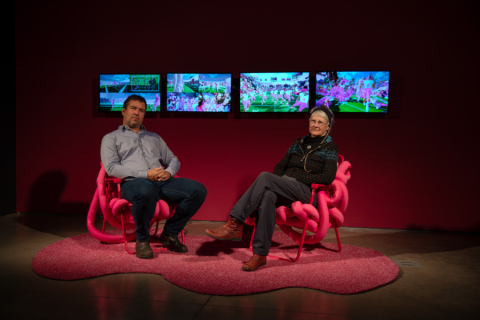Engaging the Margins: Art, Ecology and Sustainability
Beall Center for Art + Technology's exhibition reframes art, ecology and sustainability
By Christine Byrd
Wildfires, rising sea levels, nuclear waste. It’s easy to feel overwhelmed by the scale of problems humans have created that we cannot solve alone. However, art invites another perspective. At the Beall Center for Art + Technology this spring, Engaging the Margins offers eight artists’ colorful, provocative, even joyful takes on a range of prescient issues, including sustainability.
“One of the things that a show like this does is it opens doors for people to reflect on the issues without feeling sledge-hammered,” said Antoinette LaFarge, professor emerita of art. LaFarge co-curated the exhibition with Jesse Colin Jackson, associate dean of research and innovation and executive director of the Beall Center for Art + Technology.
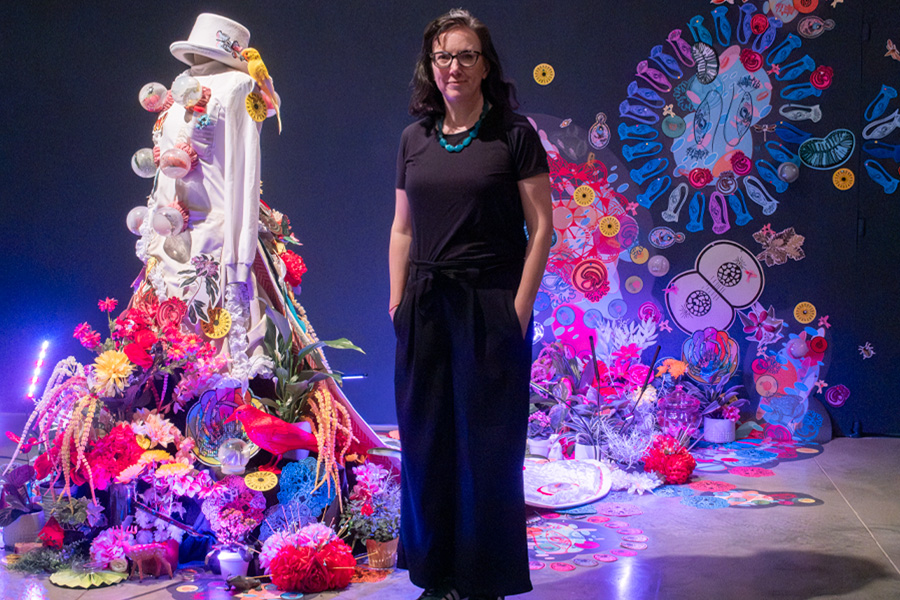
Image: Artist Jennifer Willet with her piece, Gentleman Scientist: Microecologies, 2023-25, mixed media, courtesy of the artist. Photo by Yubo Dong.
Jennifer Willett’s Gentleman Scientists: Microecologies, will draw gallery visitors’ attention with its white suit and bridal-like train adorned in potted plants and cut flowers in glass globes. Rarely do you see an artwork growing, dying and decaying in real time in a gallery setting. But here, that’s part of the invocation to think differently.
“Even in our language, we foreground the pretty things — the flowers in the globes — and say that they're decaying,” said LaFarge. “The other side is that a series of microorganisms are flourishing, so those little snow globes are at least as much about life as they're about decay. It's just that it's a perspectival problem. A lot of the work here is about trying to change the perspective slightly.”
On the opposite side of the gallery, Krista-Leigh Davis offers three interrelated pieces designed to make us rethink our relationship with extremophiles — organisms that naturally thrive in toxic environments, and are exploited to clean heavy metals from contaminated sites. In one section of her video, No Claim to the Blue-Green Bloom, Davis performs a joyful dance in the woods, to an audience of trees and microorganisms, wearing the sculpture piece The Trauma Surrogates.
“Finding the lighthearted potential of creating a different relationship with microorganisms allows us to start enjoying the world as it is,” said LaFarge. “That alone makes things seem more possible going forward because despair is our greatest enemy.”
“I think all of the pieces in Engaging the Margins are, in different ways, either joyful or surprising, or both,” LaFarge added.
Planting the Seed
The seed for Engaging the Margins was planted in 2019 when LaFarge and Jackson co-chaired a conference at UC Irvine for the Society for Literature Science and the Arts (SLSA). To accompany the event, they showcased posters from 40 artists answering the question: “What is the location of your experimental practice?” From those, the pair chose 15 artists for more in-depth interviews for a book Experimental Practices in Interdisciplinary Art: Engaging the Margins (2024). Key themes emerged from the book: a strong sense of place, a critical relationship with old and emerging technologies — and a concern for the environment and humankind’s relationship with the natural world. Those are reflected in the show at the Beall Center.

Image: Posters from the SLSA 2019 exhibition At the Margins. Photo by Yubo Dong.
LaFarge and Jackson have explored sustainability in their own artistic and pedagogical practices. Jackson has taught art courses where students create furniture from waste materials like cardboard. In 2017, he co-founded Closed Loop Plastics, a startup that made 3D printer material out of waste plastic. That endeavor was partly inspired by the amount of plastic used for Jackson’s popular Marching Cube installation, which allowed audiences to engage with an algorithm and see modular pieces form different shapes and structures. The startup shuttered five years later, primarily due to the difficulty of sourcing waste plastic, leaving Jackson skeptical of recycling programs and sustainability efforts focusing on individual behavior instead of systemic changes. Since then, he has found another sustainability practice more impactful: exposing students to ecology (see Arts & Nature callout below).
“I feel that one of the things artists do is model a way of being in the world that is a little bit different..."
“I’ve pivoted my recent sustainability efforts towards ecology. I’m enjoying working with students in nature because I’m seeing more impact there,” said Jackson. “For example, I’ve been able to bring groups of students who haven’t spent a lot of time outside of the city, witness their first encounters with the high desert ecosystem, and help them find creative inspiration from this natural environment. For me, this has been more transformative than further experiments with creating art from recycled materials.”
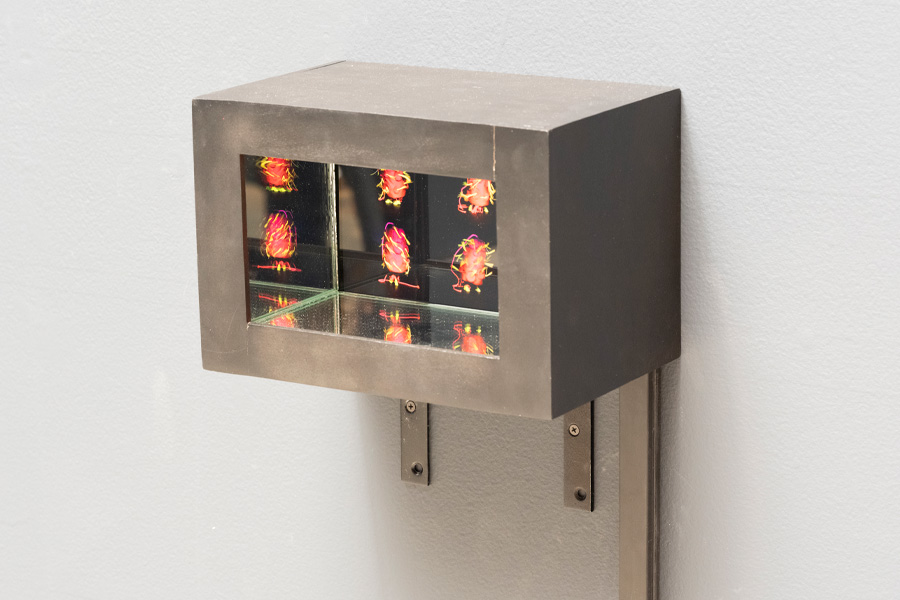
Image: Krista Leigh-Davis, Choreographies for Capitalist Ruins, 2023, video loop (3:00), wooden mirror box. Photo by Yubo Dong.
Living Differently
LaFarge, who retired from UC Irvine in 2023 after spending more than two decades helping to establish the Department of Art’s new media program, has had an ongoing interest in the themes of sustainability, ecology, technology and politics. A self-proclaimed “research junkie,” LaFarge was working on another project when she came across a 1910 women’s magazine story about Louise Brigham, an American philanthropist and designer who had developed an entire system for using recycled packing crates to make functional, affordable furniture — about 20 years before a few other designers from Western countries started working with discarded materials. LaFarge was so inspired by this foremother of green design that she wrote an entire book about her, Louise Brigham and the Early History of Sustainable Furniture Design (2019).
“I think it's easy just to imagine that sustainability started in the 60s with the hippies,” said LaFarge. “History is always, always longer than we think, and more interesting for that reason.”
LaFarge’s more recent works have a hyperlocal focus on ecology. Deep Earth (2021) looked at abandoned mines littering Fresno County through collaborative drawings with artist Christel Dillbohner. Then, Deep Water, displayed at Irvine’s City Hall in 2024, explored the invisible but essential aquifers under Orange County. These works share a commonality with many of the pieces in Engaging the Margins, trying to bring our awareness to things that are usually out of sight, out of mind.
" I’m enjoying working with students in nature because I’m seeing more impact there..."
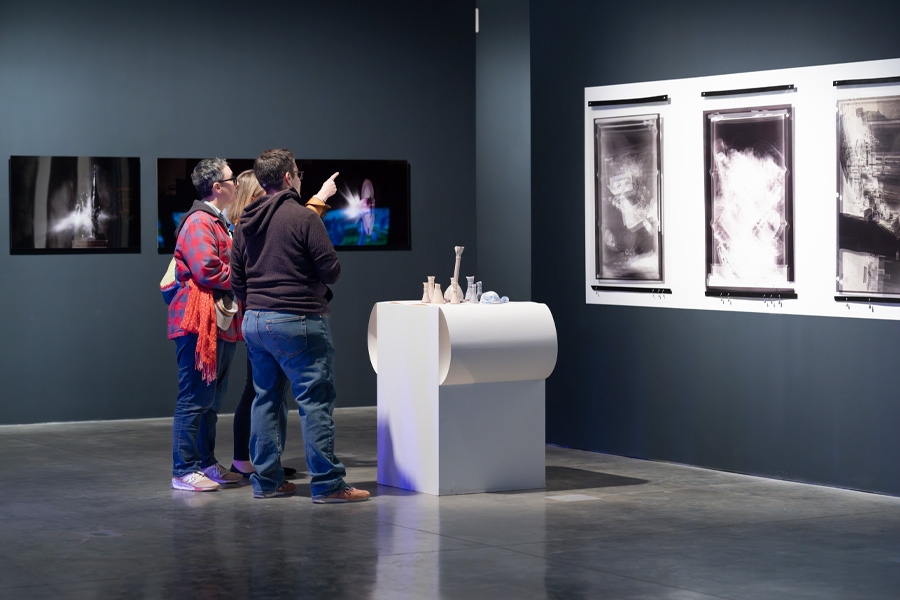
Image: (left to right) Installation view of Rebecca Cummins’ Shooting Stars, 2007, digital prints. Nina Vroemen, Lessen in Time, 2023, (video 3:22), 3 acetate prints with lead sinkers, 10 low-fired ceramic chemistry flasks seeping iodine from the crazed glaze, paper scroll. Photo by Yubo Dong.
“I feel that one of the things artists do is model a way of being in the world that is a little bit different and often a little bit more joyful,” said LaFarge. “So that's what I always want people to take away from a show — how they might live in the world differently, find a hidden part of their nature, and honor it.”
Engaging the Margins is open at the Beall Center for Art + Technology through April 19, 2025. Learn more at arts.uci.edu/event/engaging-margins.
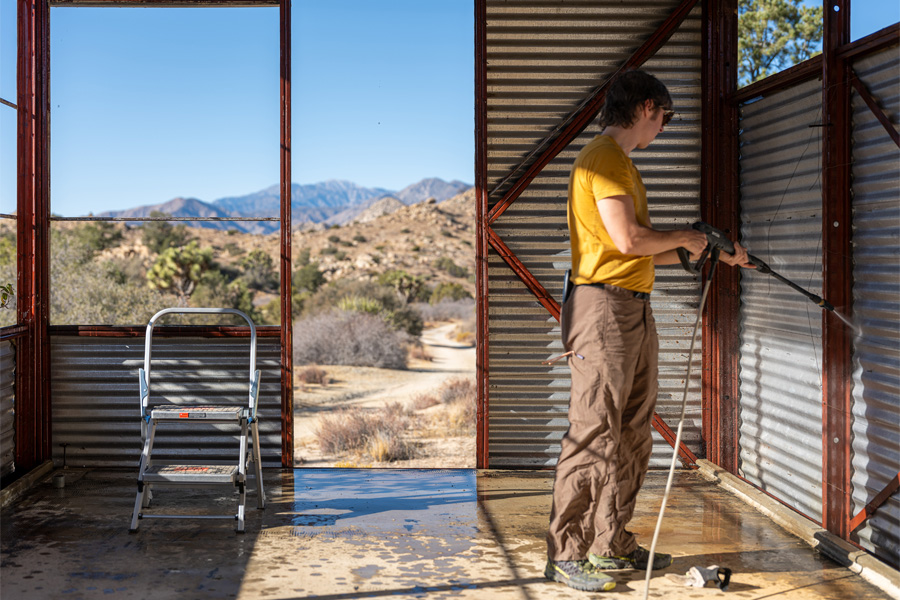
Image: Art M.F.A. student Simon Klein works to help create an interdisciplinary space at UCI's Burns Piñon Ridge Reserve. Photo by Jesse Colin Jackson.
Arts & Nature
At the western edge of the Mojave Desert, where Joshua trees give way to piñon pines, lies Burns Piñon Ridge Reserve. This unique ecosystem has become a source of inspiration and collaboration for students in the Claire Trevor School of the Arts.
“It’s been such a joy to be with all the other artists and do research together, inhabiting this fresh space,” said Simon Klein, an M.F.A. candidate in the Department of Art. “Interacting with each other, being in tune with different histories, engaging with biology texts, and making art that’s in this world has been a gratifying and unique opportunity.”
Jesse Colin Jackson, professor of art and UC Irvine faculty advisor for the preserve, has twice led a graduate course that enables students to create site-specific art, collaborate across all four departments at CTSA, and experience California’s nature in new ways.
“Ecology is a core component of sustainability, and learning from nature has always been one of the ways in which we become more sustainable,” said Jackson. “The course helps students question the sustainability of art-making in general. Where do you get your materials? How do you make sure those materials don't damage the environment? How is your art intervening in the natural world?”
The students use the space to create their own work, turning found materials into musical instruments, performing nature-inspired movement pieces and creating a sound walk for visitors to enjoy. The most transformational aspect may be the opportunity for students from different fields to collaborate and get to know one another – which the students continue back on campus.
“Sustainability is not just about the environment, it's about balance,” said Jackson. “The students are creating a more sustainable future for themselves as they broaden their networks outside of their immediate discipline, and that leads to a more resilient future.”
CTSA’s first public showcase at Burns Piñon will be in May 2025. For details, visit sites.uci.edu/artsatburns.
Please visit our secure direct giving page and make a gift to support CTSA today!

